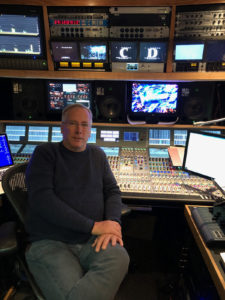 LOS ANGELES — Mike Abbott, established A1 mixer and owner of All Ears Inc., has had an extensive career mixing audio for some of the most popular TV and high-profile awards shows. For more than 25 years, Abbott has worked with various Calrec consoles, but his current console of choice is the Apollo, which he’s using on the current season of The Voice.
LOS ANGELES — Mike Abbott, established A1 mixer and owner of All Ears Inc., has had an extensive career mixing audio for some of the most popular TV and high-profile awards shows. For more than 25 years, Abbott has worked with various Calrec consoles, but his current console of choice is the Apollo, which he’s using on the current season of The Voice.
The Voice live shows run on an extremely tight schedule because they need a quick turnaround for the West coast and foreign distribution two hours after the broadcast. These elements are distributed around the world to six foreign outlets for playout the next day with local commercial and dialog integration. “The replay function on the Apollo console allows me to go from a production mix to a remix of a post-show fix with a push of a button,” says Abbott. “This is especially important when faced with a West Coast re-feed or a quick music remix half an hour before a live broadcast.”
In addition to working on The Voice, Abbott has worked on some of the most popular shows, including FOX’s New Year’s Eve 2017 telecast, SAG® Awards, 60th GRAMMY Awards, the Independent Film Spirit Awards, Shark Tank, The ESPY Awards, Stand Up 2 Cancer, Pod Save America as well as additional live streaming events for Apple Music and DirecTV’s Live 4K TV Channel.
For the majority of Abbott’s projects, he works in NEP Denali mobile trucks and most of the trucks are outfitted with Apollo consoles that have 144 or 192 dual faders on the control surface. “The dual faders allow me to put primary sources and production mics on the ‘A’ faders and secondary sources, like audience reaction mics and EVS sources on the ‘B’ faders path,” says Abbott. “For some of the larger channel count shows, I map the musical inputs to lower fader banks and assign DCA control faders to the top layer for cross fading of the musical performances. I apply memory isolation to the production faders, which allows me to have snapshot recalls for multiple musical performances that may be required without effecting production sources.”
Fader swapping is also an important feature for Abbott, who likes to lay out input sources on the console, especially when starting a new show. This feature helps Abbott re-map the faders assigned on the surface as the show develops. Throughout production, Abbott moves and consolidates the top layer with only essential faders. Having the ability to assign GPI’s to AutoFaders, and AutoFaders to faders with the Apollo console, provides Abbott with the essential control parameters, allowing for the programming of smooth transitions with the reliability and speed of operation required for live production.
“I started using Calrec in the 90’s and currently use an Apollo console to provide me with the hardware resources needed for the complex audio projects I work on,” says Abbott. “I work at a lot of different studios and remote facilities, and my experience with Calrec gives me an advantage on site when installing and building a project. The majority of the entertainment projects I have been involved with throughout my career have used Calrec consoles; 80 percent of my previous and current projects are done on Apollo consoles. Calrec has a reputation and major presence in the broadcast industry. When I set up a mix, I attempt to provide an audio perspective from the fourth row for the viewers at home, which is what an audio soundtrack for live TV broadcasts should be all about, and Calrec helps me accomplish that.”
Follow Calrec Audio:
https://www.facebook.com/calrecaudio
https://twitter.com/calrecaudio
